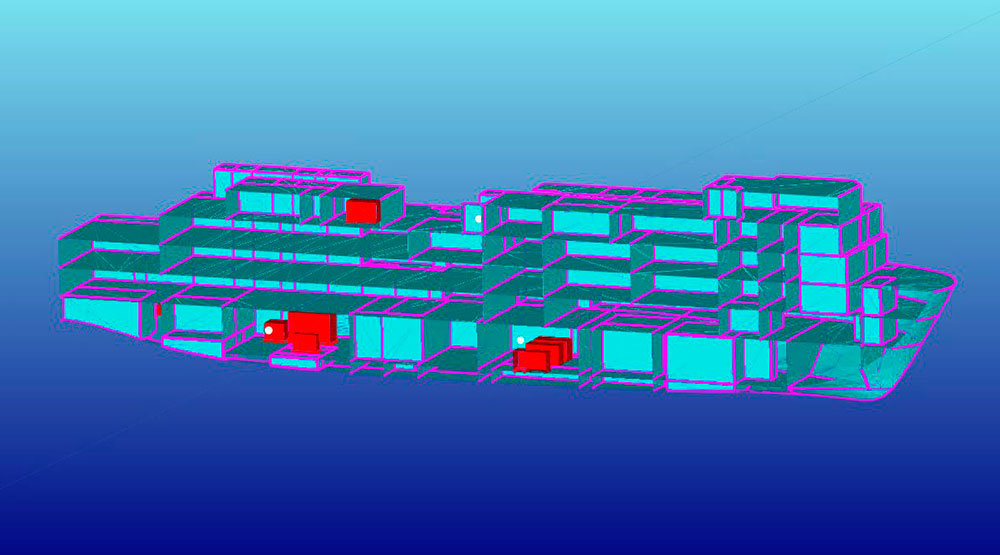Noise And Vibration
Comprehensive Management
Specialized Consultants in Noise and Vibrations
Noise and vibration comprehensive management
The methodology associated with the “Noise and VibrationComprehensive Management”, developed by TSI is supported by the experience of its implementation in the Dynamic-Acoustic design of five modern Research Vessels, which are among the most silent vessels due to the strict limits of noise-radiated to the sea.
This methodology is aimed at defining a series of actions focused on reducing the noise and vibration transmission paths from the loudest sources to the rest of the structure.

We are Consultants Specialized in the design of Silent Ships with national and international recognition
Preliminary Assessment
An initial study, based on the General Arrangement of the vessel, about locations of accommodation & work areas respect to the main noise sources is made in order to advance a first level of recommendations from the acoustic point of view. The Connectivity Matrix methodology is applied in order to identify those areas susceptible to present noise problems.
Also, a preliminary study of the structural continuity of the vessel´s structure based on its General Arrangement, Engine Room´s General Arrangement and Preliminary Structure Drawings, is done in order to advance a first level of preventive recommendations from the dynamic point of view of the vessel´s structure.
Sensitization of Suppliers
Due to Main and Auxiliary Machinery together with propeller/s are the main noise sources of Noise on board, Vibration and Noise Radiated to the Water., the correct selection of theses equipment and the establishment of contractual dynamic-acoustic criteria represent an “essential and critical” aspect to ensure compliance with Shipowner Requirements, especially those related to the protection of the crew (IMO, ILO and Flag Regulations) and the ships “acoustic signature” which must comply with the corresponding Class Note (ICES No. 209, BV NR614, DNVGL SILENT Class Notation, etc).
At this stage contract terms are defined in terms of Dynamic / Acoustic requirements that shall be implemented in the contract or purchase specifications for different suppliers.
A specific “Noise Agreement” will be signed between the Shipyard and the Supplier selected as a commitment with “dynamic and acoustical contractual clauses/criteria”.
Analysis and Simulation
During the Design Project Stage a whole package of simulation activities are done in order to achieve the following targets:
- To avoid local and global resonance phenomena in the ship structure and to guarantee that the Expected Vibration Levels in all the spaces are below the limits required.
- To calculate the Expected Noise Levels at all the spaces of the vessel considering the general arrangement, the main noise sources and the Original noise insulations proposal and the operational conditions of the ships. By comparison between these preliminary expected noise levels, for each operational condition, with the Noise Limits required, a new proposal of Complementary Noise Insulation will be submitted in order to guarantee that the Final Expected Noise Levels are below the Limits required.
- To minimise the noise and vibration transmission from the special main machinery to the ship structure foundations.
- To Calculate the Underwater Radiated Nose levels by the vessel and its comparison with the requirement defined in the Contractual Specification (ICES No. 209, BV NR614, DNVGL SILENT Class Notation, etc.
“Noise and Vibration Management” or “Comprehensive Vibration and Noise Management”, is one of the key naval services developed by TSI
Factory Acceptance Tests – FAT
These tests are focused on guarantying the compliance of the main machinery: Main Electric Motors, Gen-Sets, Propeller, Manoeuvring Propellers and HVAC System, with the dynamic requirements contractually stated by the Shipyard/Consultant to the main suppliers.
The tests are done according to the Procedure/Protocol agreed between the Shipyard-Consultant and the corresponding Supplier.
Sea Trials
In this phase of the N&VCM, a set of experimental measurements are performed during the official sea trials. The aim of these activities is to check and verify the contract requirements stated by the Shipowner and the Classification Society, related to both N&V on board and External Noise Radiated by the ship, have been successfully met.
Comfort Assessment:
- Noise & Vibration according Standard and Class Notations.
- Sound Insulation Measurements.
- Impact Measurements.
- Habitability.
- Operational Performance:
- Power & Speed test.
- Manoeuvrability test: Evolution Circle, Zig. Zag, Crash-Stop.
- Underwater Radiated Noise Measurements.
For more information visit our section Sea Trials Comprehensive Management.
Activities included in the Noise and Vibration Comprehensive Management:
- Assistance to the shipowner in the definition of contractual specifications.
- Preparation and Analysis of the Vibrations, Noise, Noise Radiated to the Harbour and Underwater Radiated Noise Specifications.
- Acoustic Criteria Definition (airborne noise and structural borne noise for critical equipment. Noise Agreement for Suppliers. Noise Prediction Calculation.
- Underwater Radiated Noise Prediction Calculation.
- Vibration Prediction Calculation.
- Design optimization from a dynamic (vibrations) and noise point of view.
- Acoustic signature optimization
- Factory Acceptance Tests.
Sea trials’ tests protocols. - Sea trials.






































